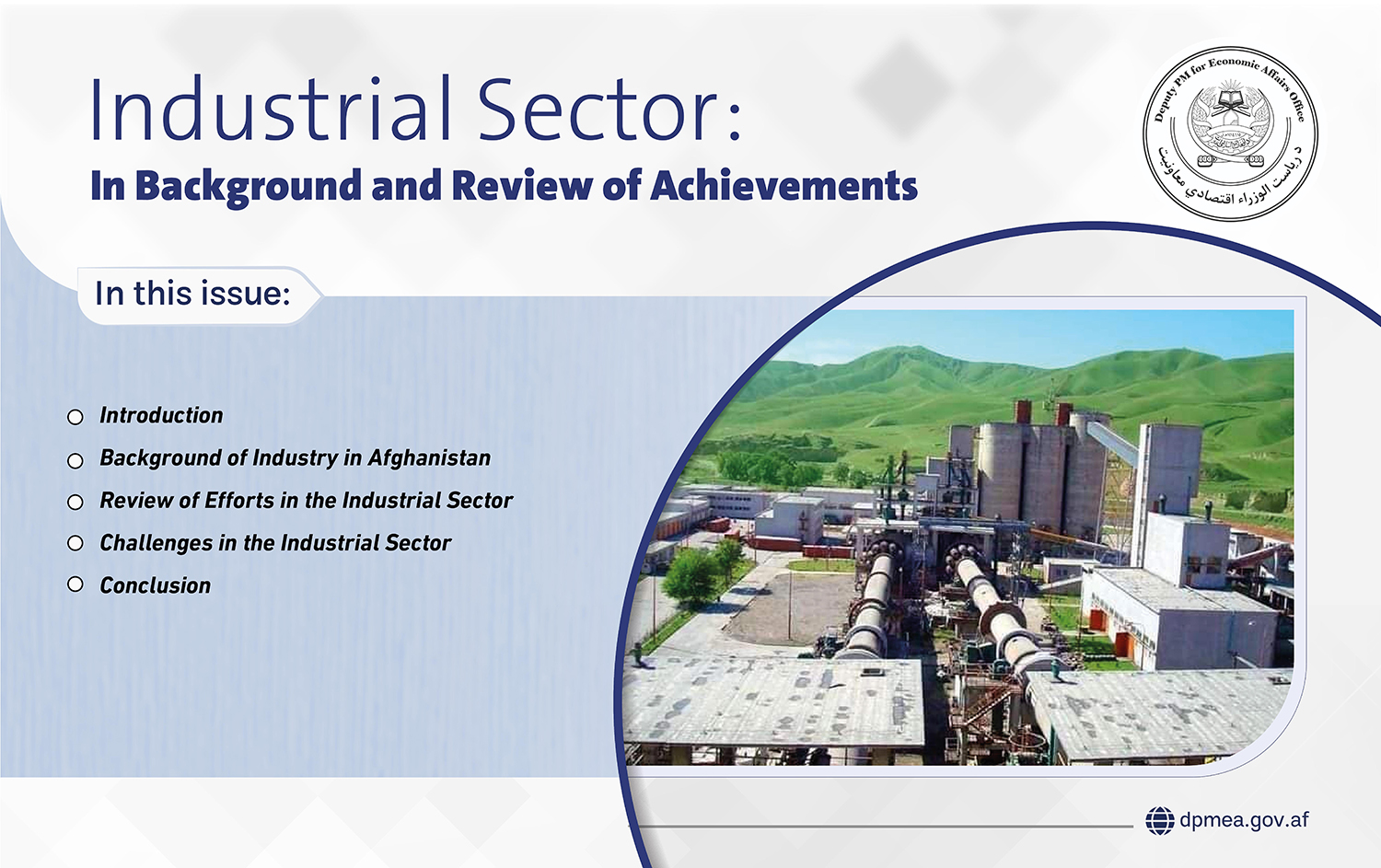Industrial Sector: Background and Review of Achievements

Author: Abdullah Emal
Translator: Sajad Ahmad
Introduction
The industrial sector plays a crucial role in economic development. It not only increases employment opportunities but also provides alternatives to imported goods, thereby reducing the country's import levels. With the advent of the Islamic Emirate, special attention has been given to the industrial sector alongside other areas. The Islamic Emirate has encouraged, supported, and ensured the safety of private investments and enterprises within the country. Currently, Afghanistan produces agricultural products, pharmaceuticals, food items, handicrafts, and several other goods.
A conducive environment has been created for investment in Afghanistan's industrial sector, attracting both domestic and foreign investors. These investments span various sectors, including chemical industries, construction materials, machinery and metal industries, pharmaceutical manufacturing, printing industry, carpentry, paper manufacturing, light industries, food processing, and many other diverse industries.
Background of Industry in Afghanistan
Afghanistan, located at the crossroads of civilizations, has a rich history of industry evident from various artifacts discovered through excavations in regions like Kapisa, Bagram, Bamiyan, and Mess Aynak. These artifacts showcase Afghanistan's ancient and long-standing industrial heritage. Traditional Afghan industries include architecture, painting, calligraphy, tailoring, pottery, carpentry, metalworking, textile weaving, shoemaking, pharmaceutical production, and carpet and rug weaving.
During the reign of Amir Sher Ali Khan, Afghanistan made some progress in the industrial sector, establishing a weapons manufacturing factory that produced both rifles and cannons. Additionally, the country's first printing press was set up in Kabul, which published several books and the renowned Shams-al-Nahar newspaper.
Under the rule of Amir Abdur Rahman Khan and Amir Habibullah Khan, further advancements were made, including factories for weapons manufacturing, coin minting, electricity production, and textile weaving. Amir Abdur Rahman Khan established the "Ilm Ganj" machine house, which, in addition to military equipment, handled printing, soap, and candle production using over a hundred large and small machines.
The industrial sector continued to flourish during Amir Habibullah Khan's era with the establishment of a leather and shoe factory and the foundation of the Jabal al-Siraj power plant. This period also saw the introduction of the first car, telegraph, telephone, and other modern devices into the country.
However, with the advent of the communist regime, the Soviet-imposed war, and later the U.S. occupation, Afghanistan's industrial sector suffered significant setbacks. The re-establishment of the Islamic Emirate has reignited efforts to revitalize the industry, yet many factories remain only partially operational, and the production levels are still insufficient to replace essential imports.
Review of Efforts in the Industrial Sector
Industry serves as the backbone of economic development in any society. Any country striving for economic self-reliance must foster both domestic and foreign investment in its industrial sector. Recognizing this importance, the Islamic Emirate of Afghanistan has created an enabling environment for investment in the industrial sector, resulting in the establishment and commencement of production in dozens of factories over the past two and a half years.
Currently, exports to approximately 80 countries across 24 commercial sectors are ongoing, originating from 13 provinces within the country. Special offices have been established to facilitate these operations.
Under the directive of the esteemed Amir al-Mu'minin Sheikh Hibatullah Akhundzada, export processing zones adhering to international standards are being established in Kabul and six other provinces, with each zone allocated 100 jeribs of land. The land transfer and ownership processes have been completed, and these zones will soon be operational to standardize the country's exports.
Furthermore, the Islamic Emirate is actively seeking potential and alternative markets for its export products in the region and globally. Requests for preferential tariffs have been made to various countries, with significant progress achieved in this regard.
The Islamic Emirate is also in discussions with reputable international companies to standardize customs and ensure valuable and reliable exports. This initiative is expected to have a substantial positive impact on the quality and quantity of exports.
Fortunately, the Islamic Emirate's economic, trade, and political relations with regional and international countries have flourished. This has positively influenced the country's trade development, reduced dependence on specific countries, and allowed Afghan products to reach alternative markets.
Challenges in the Industrial Sector
A major challenge in the industrial sector is the shortage of electricity and the high cost associated with it. To address this issue, the Islamic Emirate is working to increase domestic electricity production. Currently, projects are underway to generate tens of megawatts of solar power, and in the near future, 100 megawatts of gas-powered electricity will also be produced.
Additionally, international sanctions on the banking sector have created significant difficulties for industrialists. The shortage of raw materials within the country is another obstacle hindering the progress of domestic industries. The Islamic Emirate, in collaboration with the private sector, is actively working to address these challenges promptly.
Conclusion
Industry plays a crucial role in economic development by creating job opportunities and reducing the reliance on imported goods, thus lowering import levels. For this reason, the industrial sector is a top priority for the Islamic Emirate.
The Islamic Emirate plans to encourage and support private investment and enterprises to increase and ensure the safety of private industries. As a result of these efforts, dozens of factories have been established and have begun production in various sectors over the past two and a half years.